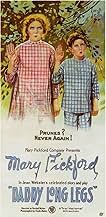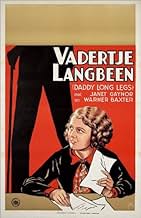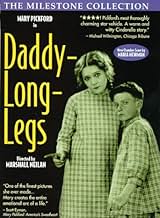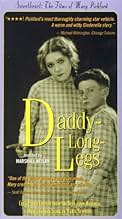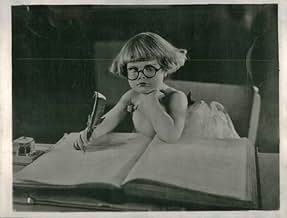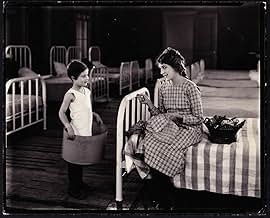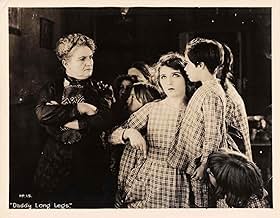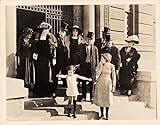NOTE IMDb
6,6/10
1,5 k
MA NOTE
Ajouter une intrigue dans votre langueAn orphan discovers that she has an anonymous benefactor who is willing to pay her college tuition, unaware he's the same man who has been romantically pursuing her.An orphan discovers that she has an anonymous benefactor who is willing to pay her college tuition, unaware he's the same man who has been romantically pursuing her.An orphan discovers that she has an anonymous benefactor who is willing to pay her college tuition, unaware he's the same man who has been romantically pursuing her.
- Réalisation
- Scénario
- Casting principal
Percy Haswell
- Miss Pritchard
- (as Miss Percy Haswell)
Marshall Neilan
- Jimmie Mc Bride
- (as Marshall A. Neilan)
Carrie Clark Ward
- Mrs. Semple
- (as Carrie Clark Warde)
Wesley Barry
- Orphan Boy
- (non crédité)
True Boardman
- Orphan Boy
- (non crédité)
James Bradbury Sr.
- Trustee
- (non crédité)
Beulah Burns
- Orphan Girl
- (non crédité)
Thelma Burns
- Orphan Girl
- (non crédité)
Ernest Butterworth Jr.
- Orphan Boy
- (non crédité)
Marion Emmons
- Orphan Boy
- (non crédité)
Avis à la une
An irrepressible orphan girl, living in the appalling conditions of a large asylum, is rescued by a mysterious benefactor and sent to college. Affectionately referring to him as DADDY-LONG-LEGS, she strives to make him proud of her. But when unexpected love comes her way, will she follow her heart or the wishes of her patron?
Mary Pickford was the greatest movie star of the 20th Century. No one else even came close to inspiring the love & devotion of the millions of fans who flocked to see her silent films. In our jaded age it is difficult to understand why a diminutive little lady could engender such ardor right around the world. For answers, one need look no further than DADDY-LONG-LEGS.
Expertly blending joy & pathos, Mary makes us instantly feel the emotions her character is living through. Whether it's stealing a doll for a dying child, dunking a bully in a well, listening to her dead mother being insulted in the worst way, or feeling the pangs & delights of a first love, Pickford tugs at our heart strings, our tear ducts, our funny bones. To watch this film is to get a glimpse as to why America's Sweetheart stands absolutely unique in her legendary status.
Although this is Mary's show all the way, in the supporting cast Milla Davenport should be noted for her vivid portrayal of the vile asylum warden. The film's director, Marshall A. Neilan, appears as a hapless young Lothario.
It was the success of this film at the box office which inspired Pickford to form a studio & become her own distributor. So it was that United Artists was born, with partners Douglas Fairbanks, Charlie Chaplin & D. W. Griffith.
The film has been beautifully restored, with a fine musical score. Notice the original `art titles,' the evocative paintings which enrich the captions.
Mary Pickford was the greatest movie star of the 20th Century. No one else even came close to inspiring the love & devotion of the millions of fans who flocked to see her silent films. In our jaded age it is difficult to understand why a diminutive little lady could engender such ardor right around the world. For answers, one need look no further than DADDY-LONG-LEGS.
Expertly blending joy & pathos, Mary makes us instantly feel the emotions her character is living through. Whether it's stealing a doll for a dying child, dunking a bully in a well, listening to her dead mother being insulted in the worst way, or feeling the pangs & delights of a first love, Pickford tugs at our heart strings, our tear ducts, our funny bones. To watch this film is to get a glimpse as to why America's Sweetheart stands absolutely unique in her legendary status.
Although this is Mary's show all the way, in the supporting cast Milla Davenport should be noted for her vivid portrayal of the vile asylum warden. The film's director, Marshall A. Neilan, appears as a hapless young Lothario.
It was the success of this film at the box office which inspired Pickford to form a studio & become her own distributor. So it was that United Artists was born, with partners Douglas Fairbanks, Charlie Chaplin & D. W. Griffith.
The film has been beautifully restored, with a fine musical score. Notice the original `art titles,' the evocative paintings which enrich the captions.
A few years back, I started to watch this film and stopped. What bothered me was that Mary Pickford near the beginning of the film playing a 12 year-old and that just seemed so silly I switched it off! However, after recently having forced myself to actually watch it all, it turned out to me amazingly good. Now this isn't to say this is a perfect film--the whole 12 year-old aspect is pretty tough to believe AND the time-line of the film is a real mess (if you pay attention, it seems that Mary goes to college and falls in love at age 12!)--they really needed to explain that a lot of time lapses between the opening scene of 12 year-old Mary and the closing scenes. However, if you ignore this, the rest of the film is very worth seeing.
The first part of the film is mostly light comedy with Mary playing a plucky trouble-maker with a heart of gold at the orphanage. Some of the stuff she gets into is pretty funny and she is about the most unwanted orphan in the film. However, about halfway through the movie, it abruptly changes to a romance. Mary is sent to college by an anonymous benefactor who does not want to be known to her, and so she labels him "Daddy Long Legs" and sends update letters to him telling him her progress--never knowing exactly who it is.
Both parts of the film work very well, but some might be bothered by it being almost like two totally different films--since the tone is so different in each. However, both elements DO work and work well. While this isn't my favorite Pickford film (I liked SUDS better and I still have a lot more of her films to see), this is among the better silent films I've seen (and I've seen a lot). A good story, excellent acting and a general likability of Pickford's character make this a good example of the genre.
The first part of the film is mostly light comedy with Mary playing a plucky trouble-maker with a heart of gold at the orphanage. Some of the stuff she gets into is pretty funny and she is about the most unwanted orphan in the film. However, about halfway through the movie, it abruptly changes to a romance. Mary is sent to college by an anonymous benefactor who does not want to be known to her, and so she labels him "Daddy Long Legs" and sends update letters to him telling him her progress--never knowing exactly who it is.
Both parts of the film work very well, but some might be bothered by it being almost like two totally different films--since the tone is so different in each. However, both elements DO work and work well. While this isn't my favorite Pickford film (I liked SUDS better and I still have a lot more of her films to see), this is among the better silent films I've seen (and I've seen a lot). A good story, excellent acting and a general likability of Pickford's character make this a good example of the genre.
This film has all the elements of the quintessential Mary Pickford film. The little girl. Spunky. Full of love and against the odds. Willing to risk. From the "ash cans" and down to earth but capable of walking with high society with her head held high. Her profile shots by Charles Rosher are the ones we've learned to remember "Little Mary" by. The cupid scenes are incredible not so much for their content but their originality and sentiment in a film made in 1919.
This sweet and funny silent stars Mary Pickford as an orphan who, after much kindhearted mischief, goes to college and finds true love, thanks to her anonymous personal trustee, whom she dubs "Daddy-Long-Legs" after the seeing his legs in a shadow. It's a familiar story, since it was remade in 1931 (with Janet Gaynor), 1938 (as the Netherlands film Vadertje Langbeen), and 1955, with Leslie Caron and Fred Astaire.
There are quite a few memorable images in this lovely version: the drunk dog, the one-armed doll, and the scene with the baby cupids.
The recent score by Maria Newman complements the movie, unlike the wretched one she wrote for another Pickford film, The Love Light (1921).
There are quite a few memorable images in this lovely version: the drunk dog, the one-armed doll, and the scene with the baby cupids.
The recent score by Maria Newman complements the movie, unlike the wretched one she wrote for another Pickford film, The Love Light (1921).
A wonderful and multi-faceted performance by Mary Pickford turns a pleasant but somewhat routine story into a fine film that is very enjoyable to watch. The story gives her a chance to use a lot of different talents, and whenever she is on-screen, which is most of the time, there is something worth seeing.
Pickford is equally charming (it seems impossible to write about a Pickford film without using that word) and equally believable as a young orphan and as a college girl. And she is equally good at creating laughs, expressing feelings, and evoking sympathy - often all at the same time, especially in the orphanage scenes, which have some of this film's best material. There is some excellent comedy that keeps the story from becoming overly cute or sentimental, and she makes the most of all of it.
They put some real work into the title cards for this one, filling them with some good art work and also using them at times for some well-chosen commentary. A couple of the other cast members are pretty good, too, although it is definitely Pickford that makes this so worthwhile.
This is an engaging little gem from the silent era, and a great example of what it was that made "America's Sweetheart" so popular.
Pickford is equally charming (it seems impossible to write about a Pickford film without using that word) and equally believable as a young orphan and as a college girl. And she is equally good at creating laughs, expressing feelings, and evoking sympathy - often all at the same time, especially in the orphanage scenes, which have some of this film's best material. There is some excellent comedy that keeps the story from becoming overly cute or sentimental, and she makes the most of all of it.
They put some real work into the title cards for this one, filling them with some good art work and also using them at times for some well-chosen commentary. A couple of the other cast members are pretty good, too, although it is definitely Pickford that makes this so worthwhile.
This is an engaging little gem from the silent era, and a great example of what it was that made "America's Sweetheart" so popular.
Le saviez-vous
- AnecdotesThis was the first film of Mary Pickford's new production deal. The part of the deal that clinched it was she was finally able to have approval over the final film edit, which she had been unable to get before. It was predicted by some to be a risky deal, but this proved to be a big success for Pickford.
- Citations
Jerusha Abbott: P-R-U-N-E spells prune / Eating them means our doom / Life's too short and death too soon / To fill our tummies with the darn old Prune.
- Versions alternativesThe Mary Pickford Foundation copyrighted a restored version in 1998 with music composed by Maria Newman. It was produced by Timeline Films and Milestone Film & Video, released on video by Milestone Films and runs 85 minutes.
- ConnexionsFeatured in Hollywood (1980)
Meilleurs choix
Connectez-vous pour évaluer et suivre la liste de favoris afin de recevoir des recommandations personnalisées
Détails
- Date de sortie
- Pays d’origine
- Langues
- Aussi connu sous le nom de
- Daddy-Long-Legs
- Lieux de tournage
- Crags Road, Malibu Creek, Californie, États-Unis(Scene where they're sitting on rocks by a pool of water)
- Société de production
- Voir plus de crédits d'entreprise sur IMDbPro
- Durée
- 1h 25min(85 min)
- Couleur
- Mixage
- Rapport de forme
- 1.33 : 1
Contribuer à cette page
Suggérer une modification ou ajouter du contenu manquant

